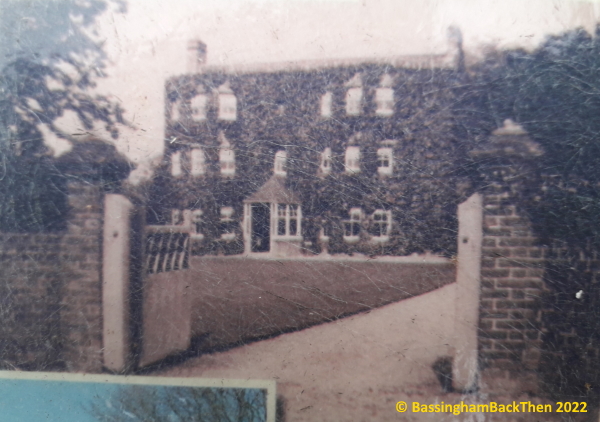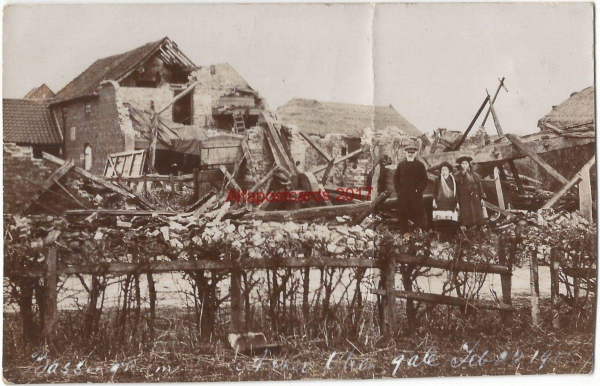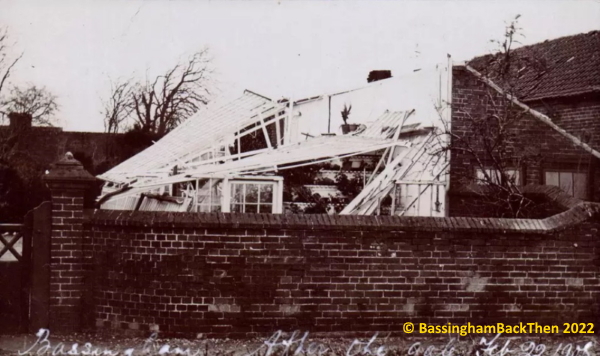Whites Lane connects Newark Road with Carlton Road at the southern end of the village. All of the original buildings from here are now gone, save one…
“Manor Farmhouse”
 Unfortunately the original picture used here is quite poor; this is because it is taken from one of the several small information boards dotted around the village. It’s the best that I can manage, I am afraid.
Unfortunately the original picture used here is quite poor; this is because it is taken from one of the several small information boards dotted around the village. It’s the best that I can manage, I am afraid.
In 1629 Henry Perkins and Edmund Settle had discussed with the Rector the enclosure of Bassingham, and a petition was sent to the major shareholder of the Manor, Lady Frances, Countess of Warwick. The Parish was finally enclosed in 1654 when the hedges were planted and the dykes were dug, and in that same year Joseph Perkins had a homestead upon this site. In 1832 Charles Hart, a builder, occupied this house and it was probably he who modernised and created the fine frontage that we see today – but not in the old photograph where the ivy runs riot! Landowner and farmer Charles Barber Marfleet brought his wife and family to live here soon after and they were to suffer some of the worst weather that Nature could throw at them.
The following three postcards show the scenes of devastation in the aftermath of “The Gale of February 22nd, 1908” when it is more than likely that a small tornado ripped through Bassingham.


I presume that the elderly gentleman in the photographs is local farmer/landowner Mr Edward Henry Marfleet who was about 55 years old at the time of this event.

Here is Mr. Marfleet again with some of his family on another postcard. In later years The Lincolnshire Echo reproduced a press clipping from the time which read, “Nowhere in Lincolnshire does the storm seem to have been felt with greater force than in Bassingham and the devastation that has been wrought is really extraordinary… At the Manor House… Master Charles Edward Marfleet, a boy of four and heir to the Boothby Graffoe estates was in the great greenhouse under the care of a lady… Hardly had the pair emerged into the yard when the greenhouse was torn to ribbons. Vast portions of it were whirled into the air, to fall back into the greenhouse area, and shattered everything within.”

Confirmation, should it be needed, that this is indeed “Manor Farmhouse” comes in the shape of the walling and the uniquely shaped capitals of the gatepost. *Misson is a village in Nottinghamshire, England. It is located 12 miles north of Retford, and not directly accessible from the rest of Nottinghamshire, as it is on the north bank of the River Idle. Misson Springs, which lie north of the village itself, is the northernmost place within the county. The parish also includes the hamlet of Newington, at its western edge. According to the 2001 census it had a population of 698, increasing to 711 at the 2011 census.
*Misson is a village in Nottinghamshire, England. It is located 12 miles north of Retford, and not directly accessible from the rest of Nottinghamshire, as it is on the north bank of the River Idle. Misson Springs, which lie north of the village itself, is the northernmost place within the county. The parish also includes the hamlet of Newington, at its western edge. According to the 2001 census it had a population of 698, increasing to 711 at the 2011 census.

 BACK HOME
BACK HOME